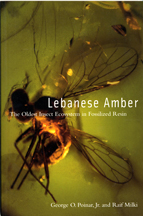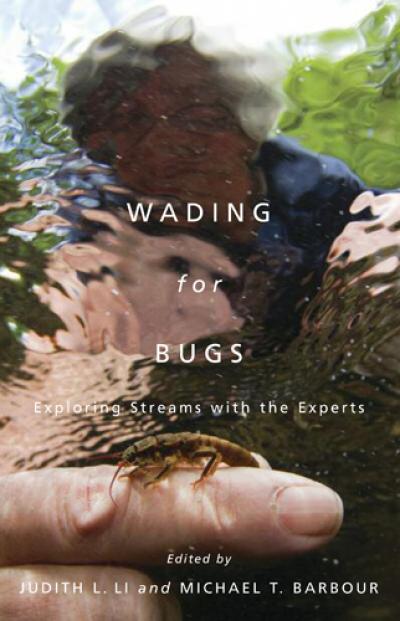
Lebanese Amber
Raif Milki and George Poinar Jr.
One of the earth's oldest natural treasures, Lebanese amber, which contains the earliest known representatives of many insect groups, unlocks the secrets of a little-known world populated by dinosaurs, pterosaurs and cycads. Dating back some 135 million years to the early Cretaceous, the amber was formed in a wet, tropical kauri pine forest long before Earth's continents reached their present positions.
This extensively illustrated book, the first major review of Lebanese amber, covers all aspects of this rare and highly valued resin, including its origin and its role as a commodity in ancient cultures. The authors discuss each plant and animal fossil thus far recovered from the amber, including nematodes, snails, mites, spiders, and insects, and the earliest complete feather. many of the fossils are represented in color and black and white photographs.
Paleotologists, biologists, and evolutionists will appreciate the book's new information, along with its summary of early research and its analysis of how amber fossils can increase our understanding of insect diversification, biogeography, extinction, and survival. With its information on the origins, characteristics, and ancient uses of Lebanese amber and other Near Eastern resins, the book will appeal to readers of natural history and gem collectors as well.
In the hands of Dr. Poinar and Dr. Milki, who have long shared a passion for these little-investigated deposits, Lebanese Amber presents a powerful, exquisitely detailed portrait of an ecosystem that, without them, might have remained lost to us forever.
About the author
Raif Milki, the foremost expert on Lebanese amber, is a professor of Public Health at the American University of Beirut, and has conducted extensive research in the field.
Read more about this author
GEORGE POINAR, JR. received his PhD from Cornell with an emphasis in entomology, botany, plant pathology, and vertebrate zoology. He has taught at the University of California at Riverside, University of California at Berkeley, and at Oregon State University. He is the author of many books, including Lebanese Amber (OSU Press).
Read more about this author
Foreword
Preface
Scientific Aspects of Lebanese Amber
Introduction
Geological Setting
Age of Lebanese Amber
Plant Source
Nature of the Cretaceous Kauri Forest
The Shifting Face of Lebanon
The Types of Inclusions in Lebanese Amber
Monera
Fungi
Plantae
Animalia
Nematoda
Mollusca
Myriapoda
Arachnida
Hexapoda
Collembola
Archeognatha
Odonata
Ephemeroptera
Blattaria
Orthoptera
Isoptera
Psocoptera
Hemiptera
Neuroptera
Coleoptera
Thysanoptera
Trichoptera
Lepidoptera
Diptera
Hymenoptera
Vertebrata
Discussion
Symbiotic Associations
Insect Diversification and distribution
Extinctions: Generic lineages
Insect-plant Associations
Insect Population Structure Over Time
Comparison of Amber Taxa with Lebanese Fish Fossils
Cultural aspects of Lebanese Amber
The Early History of Lebanese Amber
Collecting Lebanese Amber
Other Resins, Copals and Gums from Lebanon and the Near East
Acknowledgments
References
Appendix: Description of Agathis Levantensis sp. n.
Index
Amber is one of the great natural treasures of Lebanon. The scientific importance of Lebanese amber lies in its great age. This amber dates back to the Early Cretaceous and contains the oldest known arthropods of any fossilized resin deposit. These now extinct organisms lived in a forest different from any in existence today, long before the land known as Lebanon reached the Mediterranean Sea. The resin-producing woods originated in the southern hemisphere when Lebanon was part of the great continent of Gondwanaland.
Lebanese amber was formed in a tropical-subtropical forest consisting predominately of kauri pines, cycads, and ferns and dominated by reptiles including dinosaurs and pterosaurs.
This sylvan habitat contained some of the earliest flowering plants (Angiosperms), which had begun to usurp the dominating gymnosperms and spore-bearing plants. Lebanese amber may therefore hold answers to many questions about the origin of these higher plants.
All of the fossils thus far described from Lebanese amber are extinct at the species level; most are extinct at the genus level, but the majority belong to extant families. The present work includes four phyla and six classes, with insect representatives of fifteen orders, twenty-nine families, fifty-six genera, and sixty-nine species. The striking cases of four insect genera from Lebanese amber still extant today represent the longest generic lineages of any land animals.
the Early Cretaceous amber beds in Lebanon cross over the boundaries of this small country into neighboring areas. This is why these deposits are sometimes known as "Middle East," "Near East," or "Levantine" amber. However, since the vast majority of fossiliferous material so far collected and studied has come from Lebanon, the deposits are most frequently referred to as Lebanese amber.




